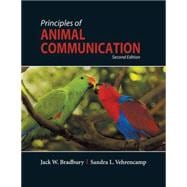Animal communication continues to be one of the most active and popular topics in behavioral ecology, neurobiology, and evolutionary biology. An enormous amount of relevant new research has been published since the first edition of Principles of Animal Communication, and over 90% of the citations in this new edition were published since the first edition appeared.
Although the basic order of topics is similar, this second edition is a completely new book. The topics in the 26 chapters of the first edition have been condensed and integrated into 16 chapters in the new version so as to better accommodate upper-division undergraduate courses with 15-week semesters. The text omits boxes and, instead, the relevant mathematics, more advanced considerations, citation bibliographies, and web links for topic enrichment have been assembled into chapter-specific and freely accessible web modules. This was done to improve the flow for undergraduates, while still providing access to more technical details and scholarly sources for graduate courses and professional users. Figures and photos are now full-color and the book has a larger format that makes for easier reading. This edition retains the broad taxonomic and sensory scope of the first edition and even adds coverage of several modalities and taxa not discussed in the first edition. As with the first edition, every chapter concludes with an itemized summary of major points and suggestions for additional reading.
As the title suggests, the emphasis in the text is on identifying general principles that apply broadly across taxa and modalities. At the same time, major effort has been expended to integrate these principles with the accepted principles of economics and other fields of science. Given this integrative nature, animal communication is a topic that can serve both as an appealing entry point to science for younger students and as a coalescing of separate disciplines for more senior ones.
For Students
Companion Website
New for the second edition, the Principles of Animal Communication Companion Website is freely accessible to all students and includes:
* Chapter Outlines for a quick overview of each chapter.
* Chapter Summaries for review of each chapter's main concepts.
* Web Topics that provide additional coverage and background material on a variety of topics throughout the textbook.
* Literature Cited for all works cited in the textbook.
For Instructors (Available to Qualified Adopters)
Instructor's Resource Library
The new Instructor's Resource Library disc includes all of the textbook's figures and tables (including photos) as both high- and low-resolution JPEG images, formatted and optimized for projection. All of the figures and tables are also included in ready-to-use PowerPoint presentations, making it easy for instructors to incorporate them into lectures.








